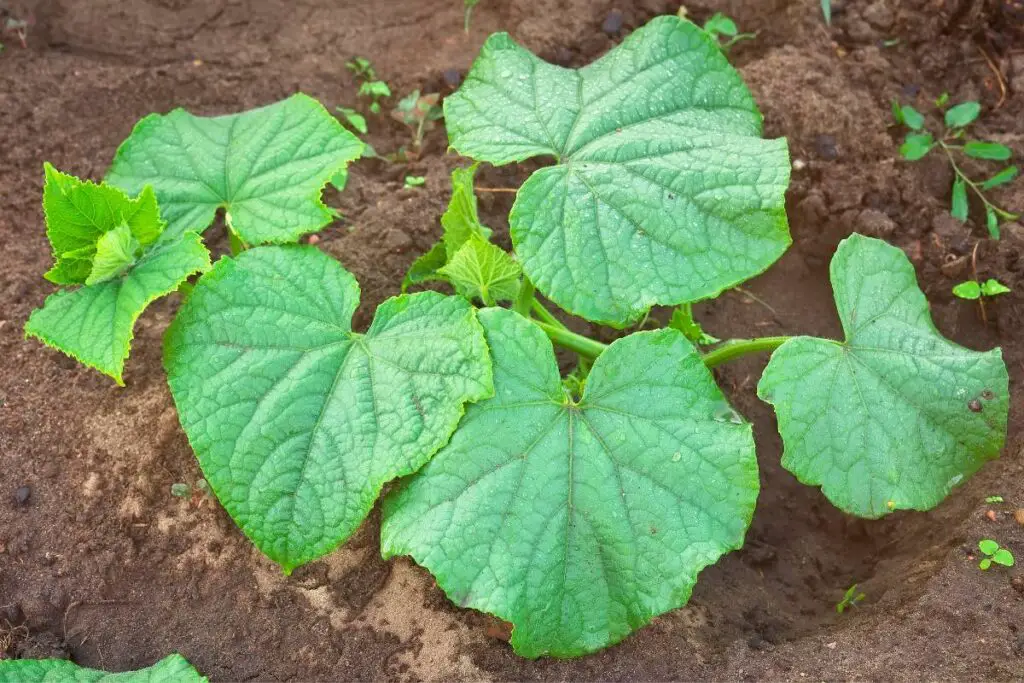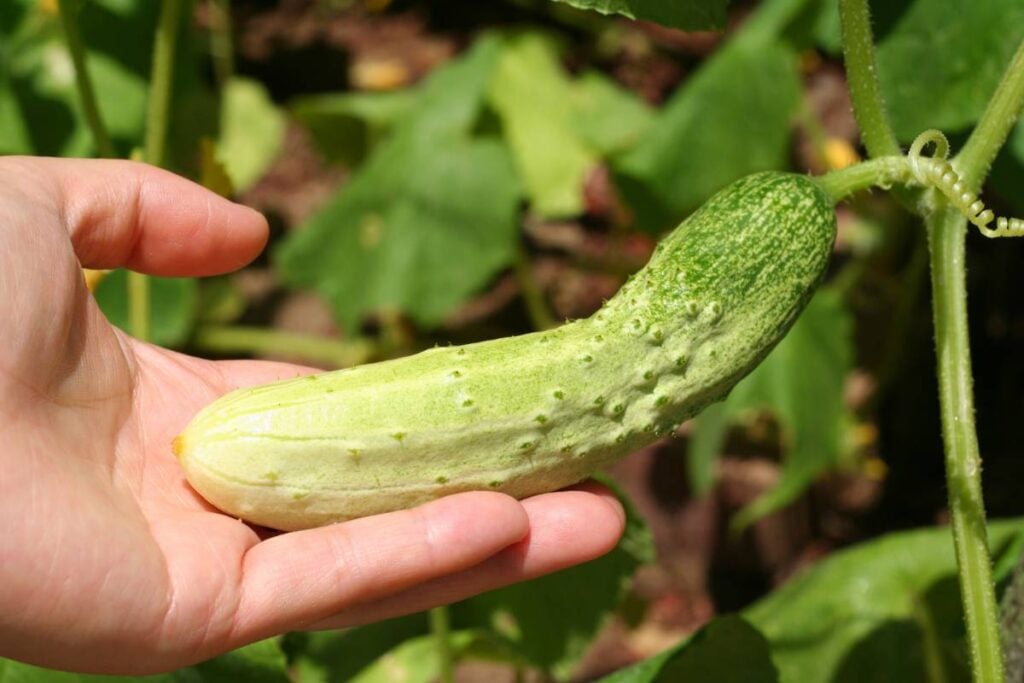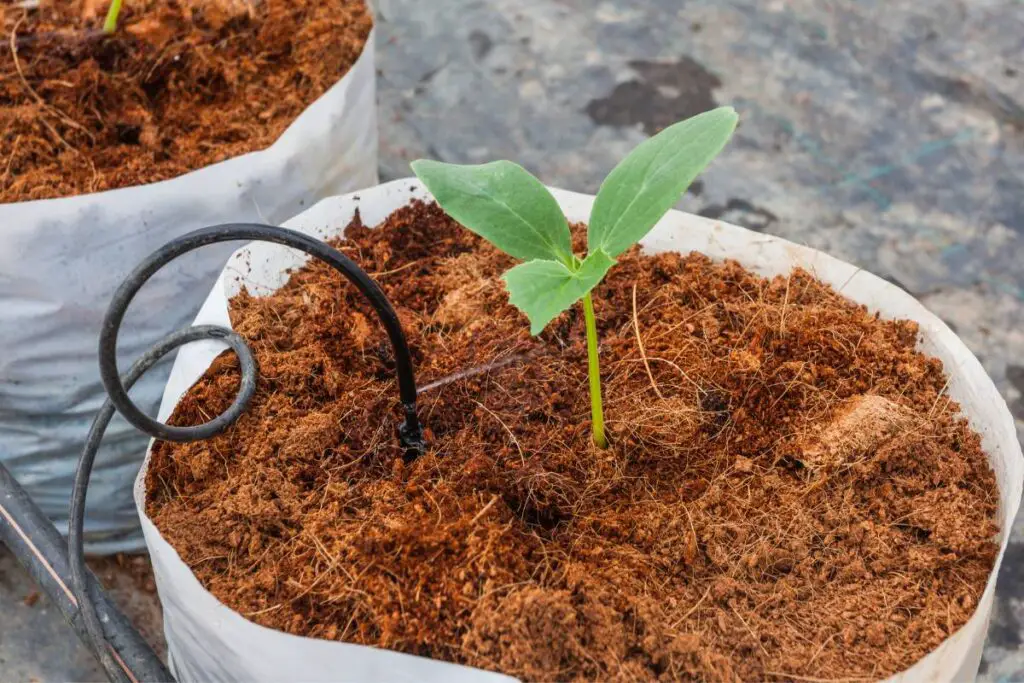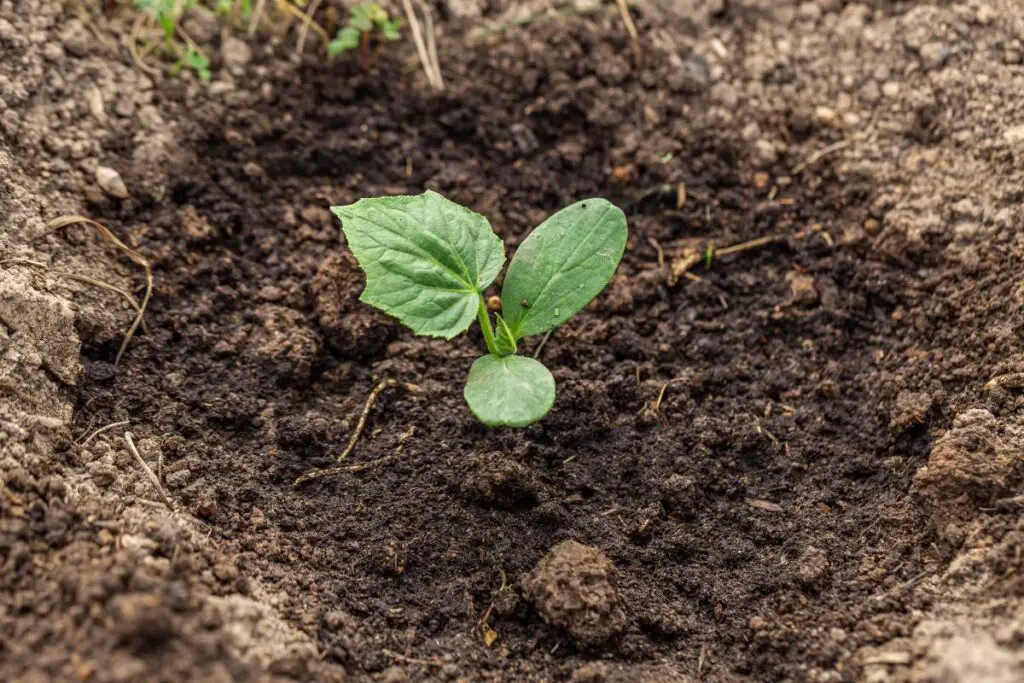When spring comes and the ground thaws, you get excited to grow cucumber plants. Cucumbers are warm-weather plants and are sensitive to cold. Know your cucumber’s temperature tolerance before planting in colder areas.
Cucumber plants cannot tolerate frost and prefer temperatures between 70-90°F. They can tolerate temperatures as low as 50°F, but prolonged exposure can stunt growth and reduce yields. It is recommended to wait until the temperature is consistently above 50°F before planting them outdoors.
Different cultivars have different temperature needs. Opt for the cold-tolerant varieties in the colder zones. This article shares the cold tolerance of cucumber plants, how to protect them from cold, and which cold variants you should plant.

Temperature range for the cucumber plants
Cucumbers are summer plants, and they love warm temperatures to survive.
The best temperature for the cucumber plants ranges between 75°F and 90°F.
They will need at least 60°F to start growing.
The temperature is optimal for photosynthesis, and the growth of healthy leaves, stems, and fruits.
The cucumbers can tolerate temperatures slightly outside the mentioned range.
But too low or high is not suitable for them.
During the day, make sure the cucumbers receive at least 65°F temperature.
The best temperature for the cucumber during the day is between 75°F and 85°F. At night, it is 60°F.
Cucumbers will handle 50-55°F temperatures to some extent.
Below this, the plant will stop growing.
If the temperature stays at its best, the plant will set fruits within 50 to 70 days.
Frost tolerance for the cucumber plants
Being warm climate lovers, cucumbers grow best where the temperature stays between 75 and 85°F.
Frost starts when the temperature reaches 32°F or below.
The plant will not survive very long when exposed to low or frost temperatures.
The lowest temperature under which the cucumber can survive is 50°F.
Below this, the leaves will turn yellow and start wilting.
At 40°F, the plant will stop growing and producing any fruits.
The cucumbers can tolerate up to 32°F for a very short time. After that, the plant will die.
Cucumbers won’t survive frost without protection.
If you belong to a colder zone, keep an eye on it and be prepared when the cold temperatures are about to arrive.
Signs and effects of cold on the cucumber plants

Being warm-season crops, these plants are sensitive to cold.
When exposed to cold temperatures, cucumber plants experience several physiological changes that will further affect their ability to photosynthesize, consume water and nutrients, and produce fruits.
When the plant is suffering due to cold, it will show you some of the following signs:
Wilting and discoloration
Wilted leaves are cucumber plants’ most noticeable signs of cold damage.
Cucumber plants suffer from moisture consumption due to the root system’s cold damage.
Leaves will appear yellow or brown, and the plant will suffer from stunted growth and wilting. The stems become dark.
If you do not treat this, the wilting will kill the plant.
Chlorosis
Another sign of cold damage is chlorosis.
The leaves turn yellow under cold stress because they fail to produce enough chlorophyll.
It further affects photosynthesis and results in reduced yields.
Stunted growth
When the temperature around the cucumber plants drops below 50-55°F, the plant has stunted growth because the tissues inside the plant start getting affected.
The leaves will droop and turn yellow, there will be no fruits, and you will notice slow growth.
Even if there are fruits, they will be small, dry, and less plumpy.
Fruit distortion
When the plant stays in cold temperatures for too long, along with the leaves, the fruits, too, get affected.
The cucumbers exposed to low or frosting temperatures will make them stiffer, distorted, less juicy, and plumpy.
The size of the fruit will also become more petite than usual.
Looking for gardening supplies? We have tested 100's of products before recommending them to you guys. Check out our best pick below:
| Image | Gardening Supplies | Best Price? |
|---|---|---|
 Top
Top Top
Top | Raised Garden Bed Kit | Check On Amazon |
 | XLUX Soil Moisture Meter, Plant Water Monitor, Soil Hygrometer Sensor for Gardening, Farming, Indoor and Outdoor Plants, No Batteries Required | No Results |
 Top
Top Top
Top | 82 Pcs Garden Tools Set and Extra Succulent Tools Set | Check On Amazon |
 | Joeys Garden Expandable Garden Hose with 8 Function Hose Nozzle, Lightweight Anti-Kink Flexible Garden Hoses, Extra Strength Fabric with Double Latex Core, (50 FT, Black) | No Results |
 Top
Top Top
Top | Dual Chamber Compost Tumbler | Check On Amazon |
 Top
Top Top
Top | Sunnyglade Plant Stakes | Check On Amazon |
 Top
Top Top
Top | Organic Cold Pressed Neem Seed Oil | Check On Amazon |
 Top
Top Top
Top | Mighty Mint Gallon :-Insect and Pest Control Peppermint Oil | Check On Amazon |
 Top
Top Top
Top | Scotts DiseaseEx Lawn Fungicide | Check On Amazon |
 Top
Top Top
Top | Jacks Classic 20-20-20 All Purpose Fertilizer | Check On Amazon |
 Top
Top Top
Top | 30,000 Seeds Pollinator Attracting Wildflower Mixture | Check On Amazon |
 Top
Top Top
Top | Survival Vegetable Seeds Garden Kit-Over 16,000 Seeds | Check On Amazon |
Effects of cold damage
When the cucumber is exposed to cold temperatures for too long, it will lead to:
- Reduced number of fruits
- Late in the harvest
- Weak and distorted fruits
- Overall damage to the plant
- Ultimately, economic loss.
Protecting the cucumber plants from cold

There are several ways to save cucumber plants from cold weather.
Protection is needed when you are growing them outdoors.
Below are some preventive measures to take to protect the cucumbers from suffering from cold and dying:
Avoid open areas
Before you transplant the cucumbers, find a place that is not open and remains sheltered from cold winds.
Choose areas along the fences, walls, or other structures.
These areas can block the cold air from reaching the plants and keep them warm, along with the direct sunlight in the winter.
Grow seedlings indoors
The best way to protect your cucumber plants during the cold weather is to start the seeds indoors.
By the time the seedlings get ready for transplant, the weather outside should become warmer and ideal for the cucumbers.
Keep the cucumbers inside your house if the weather is yet to become warm.
Cold frame for seedlings
Sometimes, you might want to transplant the seedlings outdoors a little earlier than recommended because your house might have too many plants.
In such a condition, use a cold frame for the seedlings outdoors.
A cold frame is a short wooden frame with a glass top, giving the feel of a miniature greenhouse.
Many cold frames automatically open when the temperature increases inside the frame and close when the outside cold enters.
When the seedlings mature, shift them directly to the cold frame.
To check the temperature of the cold frame, use a thermometer and monitor it daily.
Keep watching the weather and be prepared for frost and cold weather.
Use black plastic
When the days are sunny but cold, take advantage of the sunlight.
Put black plastic over the soil where you want to plant the cucumbers.
It will absorb the energy from the sunlight and warm up the air and the soil underneath.
This greenhouse effect will prevent the sun’s heat from leaving the soil and air under the plastic.
Make holes in the plastic, and plant the seedlings into the holes.
The plastic will make a water barrier. Ensure to provide enough moisture to the soil before you put the black plastic.
Also, apply some fertilizers in the soil before you lay down the plastic.
Use cloches for young plants
Cloch is an easy technique to keep young cucumbers warm during cold weather.
It is a cover that protects the plants from wind and cold temperatures.
The cloche is a bell-shaped glass cover that is put over the plant. Now, these cloches are made of plastic.
A wire cloche protects the plants from rabbits and other pests.
Keep a plastic or row cover material over it to keep the plants warm.
The cloche’s top has a hole to let the plants breathe and excess heat to pass out.
It can also keep the pests from damaging your plants.
To make a cloche, collect empty plastic containers, cut the bottom, and put it over the plants.
Remove the container cap to let the plants breathe on hot days.
There is one drawback – the cucumbers will outgrow it.
But it can still be helpful for your plants until the cucumbers outgrow.
Use a greenhouse for taller plants

The best way is to transplant them directly into the greenhouse.
You can build one independently, hire someone for help, or buy a prefabricated greenhouse.
Before transplanting the cucumbers, use a thermometer to check the greenhouse’s temperature.
When the temperature during the day is 65-75°F, transplant them.
After moving the plants, keep the door closed at night to keep the warmth trapped inside.
Remember that excessively high temperatures will also kill the plant.
Ensure the temperature does not go beyond 85 to 90°F.
Use row covers for tall plants
If your cucumber plants have become too tall, use row covers to keep them warm.
Bend plastic rods into half-hoops and stick the end sticks into the ground.
After lining enough rods over the cucumber rows, put a long garden fabric over the hoops.
Place the rocks on the edges to hold the fabric in place.
Remember to remove the fabric during the hotter days.
The thicker the cover, the more protection the plants will receive from cold weather. It will also avoid pests.
Watch for the weather forecast
Keep an eye on the weather forecast of your region.
If the weather suspects a cold snap, bring your cucumbers inside your house, or cover them with row covers and cold frames.
Starting cucumbers early
If you live in the colder zones where frost is expected, you receive a short growing season for the cucumbers.
So, start cucumbers early to receive an extended growing period.
By the time the outdoor temperature rises to 75 to 85°F, the seeds you have started indoors will get ready to be planted outside.
Sow the seeds indoors in a germination tray or pot 4-6 weeks before the last spring frost.
Some gardeners suggest sowing the seeds indoors for about 3 weeks before you plan to transplant them outside.
Transplant the seedlings 2-3 weeks after the last spring frost.
Below are some tips to start cucumbers early indoors and when to shift them outdoors:
Start early sowing indoors
For most cucumber seeds, the soil outside needs to be at least 60°F.
The ideal soil temperature for the cucumbers should be at least 65 to 95°F.
You cannot receive this soil temperature outside in cold climates.
You must wait a long time to let the soil temperature warm up.
And if you wait for so long, the cucumbers won’t receive enough growing season.
To warm the soil in the pot or germination tray, use a heat map or cover the container with black plastic and leave it near a sunny windowsill.
Check the weather forecast of your region
To grow the cucumbers early, track the weather conditions and wait for the right time to shift the seedlings outside.
Nature can be unpredictable.
The frost dates are no doubt reliable, but you may sometimes see the growing season having strange weather conditions often.
So keep an eye on the weather, especially when the days of transplanting the seedlings outdoors approach.
If the weather says there will be some unreasonable cold climate, keep the seedlings inside for a little longer.
If you have cold-tolerant plants, you can put them out outdoors.
However, you must watch the weather and protect the plants from the cold.
Choose the right location to transplant the seedlings
When you grow cold-tolerant plants, you worry less about shifting these plants outside.
You can keep them at a place where cold air keeps blowing.
Cucumbers grow best in full sun.
So, even if you keep them in your cool place, ensure they get 6-8 hours of sunlight.
The soil remains warm with more sunlight, and the plants perform better.
Before moving them outside, you must acclimate them.
Read on to know how to harden off the seedlings.
Planting time
The best time to sow the seeds is when the soil temperature rises to 65°F. Below 60°F, the seeds will not germinate.
So, starting the seeds indoors is best if you live in colder zones.
The right time is 4 to 6 weeks before the last frost.
When they grow into seedlings, the soil temperature should rise to 65 to 70°F.
The proper planting time for direct sowing is 2 to 3 weeks after the last frost. By that time, the soil temperature should be 65 to 70°F.
Soil preparation
Preparing the soil for planting cucumber starts in the fall.
Dig the soil around 25 to 30 cm deep, add some organic matter, and mix them well.
It should improve the soil quality and make it ideal for cucumber growth.
If the soil quality degrades, dig the soil again a week before planting, break the lumps, and remove the weeds.
Make 20-30 cm deep grooves and fill them with organic manure, mix them well, and cover them with film.
One day before planting, add some phosphate and potassium salt.
Next day, plant the seedlings 24 inches apart. Water them well and start fertilizing them when flowers appear.
Hardening off the cucumber seedlings

Cucumber plants have many varieties, and they have varying degrees of hardiness.
Some cucumber varieties are cold-tolerant plants that can tolerate cold climates.
Gardeners recommend them in regions where the growing season is shorter and the weather is cold.
To avoid cold damage in the cucumber plants, you must harden the seedlings while moving them outside.
The plants need to be gradually acclimated to the outdoor conditions.
Indoors, they are safe from the wind, direct sunlight, UV rays, and sudden temperature fluctuations.
To acclimate, put the seedlings on the balcony for a few hours.
Continue the process when the temperature rises to 50°F.
Slowly increase the timing of exposure to sunlight and outdoor elements.
At the end of the hardening process, provide at least 4 to 6 hours of sunlight daily.
During the day, if the daytime temperature exceeds 59°F and the nighttime temperature does not go below 50-55°F, keep the seedlings on the balcony.
This will help the plant adjust to the sudden spring temperature fluctuations.
Cucumber plant care during cold weather
Follow the following tips to care for the cucumber plants in cold weather:
- Grow them in pots if you belong to colder zones. It will let you transplant them inside when the weather gets too cold.
- Keep your cucumber plants in a warm sunny area of your garden. The more warmth they receive, the better they will perform.
- Use raised beds. They stay warmer than the ground’s soil and protect them from cold air.
- Cover the cucumbers with row covers or frost blankets when the temperature in your area drops below 50°F. The covers will retain the heat and protect the plants from cold or frost stress.
- Water your plants but be careful about overwatering. Since the weather is cold, the soil takes time to dry out. Always use room-temperature water for the cucumbers.
- Add a thick layer of mulch around the plants. This will keep the soil warm and also won’t let the soil lose moisture.
- Bring the plants inside your house, greenhouse, or sunroom when the temperature drops below 40-50°F.
- Grow cucumbers in a greenhouse to avoid the frosty weather from killing them. Make sure they receive ample light, be it natural or artificial.
Cucumber varieties and their cold tolerance
Choosing suitable varieties of cucumbers to plant in cold weather is essential.
Your plants have the least risk of getting cold or frost damage with these varieties.
Based on where you live, you must choose a variety that can tolerate cold and also are fast maturing plants.
Here is a short table of famous cucumber varieties, their ideal temperature, and their cold tolerance:
| Cucumber Variety | Temperature Tolerance | Cold Tolerance | Frost tolerance |
|---|---|---|---|
| Marketmore 76 | 50 to 85°F | Moderate | No |
| Lemon | 60 to 95°F | Yes | No |
| Diva | 55 to 95°F | Yes | No |
| Bush Champion | 50 to 90°F | Moderate | No |
| Cool Breeze | 50 to 90°F | Yes | No |
| Bushy | 50 to 90°F | Yes | Yes |
| Green Slam | 55 to 90°F | Yes | Yes |
| Siberian | 40 to 85°F | Very tolerant | Yes |
| Northern Pickling | 45 to 95°F | Yes | No |
| Armenian | 60 to 95°F | Yes | No |
| Suyo Long | 60 to 95°F | Yes | No |
Cold-tolerant and fast-maturing plants
Below is a list of some cold-tolerant and fast-maturing plants ideal for most colder zones:
- Socrates – The variety matures within 52 days. The fruit grows 7 to 8 inches long and is a parthenocarpic variety. So you don’t have to worry about pollination. It is also resistant to powdery mildew.
- Corinto – This F1 hybrid variety matures within 48 days and is more tolerant than the average cucumber plants. The fruit grows about 7 to 8 inches long, has dark green skin, and is resistant to various cucumber diseases.
- Wisconsin – This pickling variety matures within 65 days and is specially bred to tolerate the cold of the northern regions. The variety is resistant to various diseases, primarily the mosaic virus.
- Bushy – The cucumbers mature within 46 to 49 days. The vines are 3-5 feet long, and the fruit is excellent for making pickles.
- Russian – This heirloom from Russia matures within 50 days. The fruits are 6 to 8 inches long and great for making pickles.
- Amour – The fruit reaches about 4 to 5 inches long within 47 days. The variety is parthenocarpic and can resist various diseases, especially powdery mildew.
Other tolerant varieties include:
- Marketmore 97
- Suyo long
- Diva
- Titan (known to tolerate up to 50°F temperatures)
- F1 hybrid Mayar
- F1 hybrid Sila TS-217
- F1 hybrid TS-777
- F1 hybrid JAWAD
Final thoughts
Cucumbers are warm-weather lovers. If exposed to temperatures below 50°F, the plant will suffer and die. It can tolerate 32°F, but not for long. Over time, it will show signs like wilted leaves, chlorosis, discolored stems, stunted growth, and deformed fruits and end up dying.
Protect the plants using cold frames, row covers, or black plastic. Or, bring them inside your house or greenhouse. In a colder zone, avoid growing them directly in the ground. Instead, opt for pots to shift them whenever you need to.
While transplanting the seedlings outdoors, acclimate them first. The weather remains mostly cold in the colder zones, and the cucumbers receive a shorter growing season. The best option is to grow cold-tolerant plants like Socrates, Wisconsin, Bushy, Marketmore 97, Diva, Corinto, etc.
Can you grow cucumbers all year round outside?
Growing them outdoors throughout the year is fine if you are from warmer zones. But in a colder zone, grow them in pots. This way, you can bring them in during the cold days.
At which lowest temperature will cucumbers die?
Cucumbers will tolerate up to 40°F and sometimes 32°F. But it won’t be able to bear it for too long. Ultimately, they will start showing signs and end up dying if you don’t protect them.
Reference: Cucumber Wikipedia
